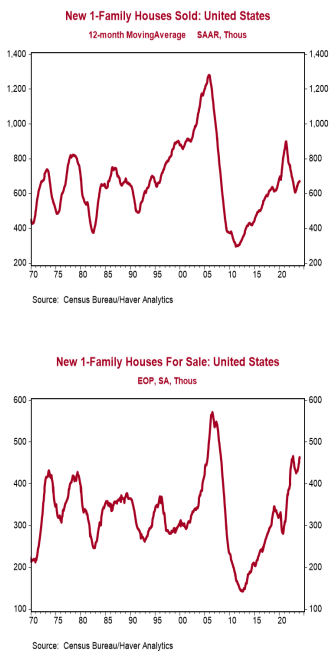- New single-family home sales declined 0.3% in February to a 0.662 million annual rate, below the consensus expected 0.677 million. Sales are up 5.9% from a year ago.
- Sales in February fell in the Northeast and Midwest but rose in the South and West.
- The months’ supply of new homes (how long it would take to sell all the homes in inventory) increased to 8.4 in February. The gain was due to both a slower pace of sales and a 6,000 unit increase in inventories.
- The median price of new homes sold was $400,500 in February, down 7.6% from a year ago. The average price of new homes sold was $485,000, down 2.8% versus last year.
Implications: Not much to get excited about in the new home sales market, which took a breather in February following two consecutive gains. The good news is that the worst of the headwinds for new home sales are in the rearview mirror. The main issue with the US housing market has been affordability, so it’s not surprising that 30-yr fixed mortgage rates recently falling roughly one percentage point due to anticipation of Fed rate cuts in 2024 has helped sales activity over the past few months. That said, higher financing costs are still taking a bite out of buyer’s purchasing power. Assuming a 20% down payment, the rise in mortgage rates since the Federal Reserve began its current tightening cycle amounts to a 19% increase in monthly payments on a new 30-year mortgage for the median new home. The good news for potential buyers is that the median sales price of new homes has fallen nearly 20% from the peak in 2022. However, it’s important to note that this drop in median prices is likely due to the mix of homes on the market including more lower priced options as developers complete smaller properties. Supply has also put more downward pressure on median prices for new homes than existing homes. The supply of completed single-family homes is up nearly 175% versus the bottom in 2022. This contrasts with the market for existing homes which continues to struggle with an inventory problem, often due to the difficulty of convincing current homeowners to give up the low fixed-rate mortgages they locked-in during the pandemic. But this does not mean that housing is getting more affordable per square foot, with the Census Bureau reporting median prices on this basis up 45% from 2019 to 2022, the most recent data available. Though not a recipe for a significant rebound, more inventories giving potential buyers a wider array of options will continue to put a floor under new home sales. One problem with assessing housing activity is that the Federal Reserve held interest rates artificially low for more than a decade. With rates now in a more normal range, the sticker shock on mortgage rates for potential buyers is very real. However, we have had strong housing markets with rates at current levels in the past, and as long as the job market remains strong, homebuyers will eventually adjust.





